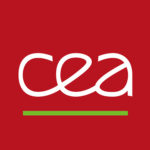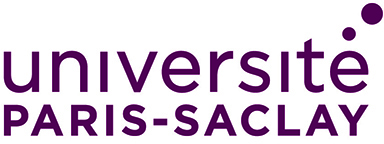SRMP CEA facility
JANNuS-Saclay

Introduction
Ion beams are employed to understand neutron-induced effects in nuclear materials for decades as they can produce nuclear recoil damage and implant a large variety of elements mimicking helium and hydrogen from nuclear reactions, transmutation products, fission products and gasses [G.S. Was, and R.S. Averback : Radiation Damage Using Ion Beams. Comprehensive Nuclear Materials 1, 195 (2012)]. Among the most stringent reasons for using electrostatic ion accelerators are the scarcity of neutrons sources and the ease of use : a high damage level either as implanted ions and/or as dpa is obtained over a very short time –typically a few hours– and the irradiated sample has no residual radioactivity. Ion beams allow also to perform well controlled experiments in terms of energy, dose, flux, temperature… with little variation during the irradiation. This is of great value in an analytical approach.
At CEA Paris-Saclay, a triple beam facility has been installed for simultaneous ballistic damage, gas implantation and/or electronic excitation. Samples can be irradiated in the wide temperature range from liquid nitrogen to 850K. Evolution in the ion-irradiated material microstructure and changes in the service properties (mechanical, thermal…) are then characterized by on line Raman spectrometry or post mortem. Simulation can greatly help in validating the transposition of material laws derived from ion irradiations –formation and evolution of defect loops and of cavities, segregation, amorphization– to in-reactor conditions.
Together with JANNuS-Orsay at IJCLab, it forms since 2005 the multi-ion beam irradiation platform JANNuS for Joint Accelerators for Nanosciences and Nuclear Simulation.
Ion sources and accelerators
The JANNuS- Saclay facility comprises three electrostatic accelerators (respectively named Épiméthée, Japet and Pandore) connected to a triple beam chamber for single-, dual- and triple beam irradiations. Two other chambers are linked to Épiméthée and Pandore for single beam irradiation and/or Ion Beam Analysis. The layout is divided into six linked rooms, separated by suitable concrete walls for radioprotection safety.
Artistic view of the JANNuS-Saclay facility
Epiméthée :
Épiméthée is a 3 MV single-ended electrostatic accelerator (3-UH-2 Pelletron, National Electrostatics Corp.) equipped with an electron cyclotron resonance (ECR) source (Pantechnik, Nanogan type) able to provide highly damaging beams with large energies and ranges, and also gases : hydrogen, oxygen, noble gases. The ECR source produces high charge states of a variety of ion species, which in combination with the 3 MV acceleration potential can produce ion beams with energies as high as 36 MeV. The source is equipped with four bottles for such gases as O2, He, Ar, Xe, CH4 and two cartridges of volatile organometallic compounds such as ferrocene and W(CO)6 for producing Fe and W ions. Maximal current at target is for example 150 µA for protons and He+, 12.5 µA for Fe5+ to 80 nA for Fe10+, 5.5 µA for W4+ to 2.5 µA for W12+. Metal ions are produced by the MIVOC process. Fe8+ up to 24 MeV and W12+ up to 36 MeV are classically used to produce high damage levels up to 2 – 3 µm range with damage rate typically over a dozen dpa/h at peak.
Japet :
Japet is a 2 MV Tandem Pelletron (6SDH-2, National Electrostatics Corp.) equipped with an external SNICS-II ion source (negative ions by cesium sputtering) which can deliver electronegative ions such as Cl, I, C, Si, V, Cu, Zr, Ag, Au… This system is capable to produce energies of 0.5 to 4.0 MeV for single-charged ions, up to 6 MeV for double-charged ions, and correspondingly higher energies for ions of higher charge states. The SNICS-II source is naturally very efficient for halogen ions : chlorine and iodine. Yields for Cu, Au and Al are excellent. Si ions are also abundant. Ni, Ti and Zr ion beams have a quite satisfactory flux, but hardly above 14 MeV, 10 MeV and 12 MeV respectively. Weaker V, Ag and Nb beams can also be produced.
Maximal current at target is for example 50 µA for protons, 1.5 µA for Au4+, 1.3 µA for Al3+, 18 µA for Si3+ or 4.3 µA for Ni2+.
Pandore :
Pandore is a 2.5 MV single-ended electrostatic accelerator (7.5SH-2 Pelletron, National Electrostatics Corp.) equipped with a RF source which produces single-charge ions. Six gas bottles are installed in the vessel that allow producing protons, deuterium ions, helium-4 and helium-3 ions. This accelerator is used for implantation as well as for IBA. Maximal current at target is for example 2 µA for protons and 9 µA for 4He.
Ions production :
The three accelerators offer a wide range of beams and more ions have still to be tested. Four gases and two metals are available on Épiméthée. Pandore produces different H and He isotopes. Japet uses a single solid cathode that can be rapidly changed. Combining these many beams enables a variety of dual beam and triple beam conditions that mark the richness of JANNuS-Saclay.
IMAGE à inserer
Ions available from the JANNuS-Saclay accelerators (in blue Épiméthée, in green Japet, in pink Pandore). Among them, more than 20 ions have been successfully tested.
Irradiation chambers and on-line controls/measurements
Vacuum chambers for irradiation and ion beam analysis :
The triple beam chamber receives one beam line coming from each of the accelerators, allowing single, dual or triple beam irradiations. Each one of the beam lines, converging towards the triple beam chamber with an incidence angle of 15 °, is equipped with a raster scanner unit able to spread the beam homogeneously over an area 2 cm in diameter on the sample surface.
Triple beam irradiation chamber
Each beam line can be equipped with an energy degrader in order to produce a roughly homogeneous irradiation damage and implantation(s) along the whole ion range. The degraders are constituted by rotating wheels mounted with suitable thin foils, typically 25 to 250 µg.cm-2 carbon foils or aluminum from 0.8 to 5 µm thick. Degraders induce ion loss due to divergence after scattering in the foils and straggling in the thickest foils. These phenomena have to be taken into account for the calculation of the implantation profiles. Self-ion effect due to the superimposition of the damage region with implantation is taken into account by selecting an appropriate observation depth in the sample.
The sample holder mounted on the rear part of the chamber covers the temperature range from liquid nitrogen to 800°C. On the top of the chamber, a pneumatic system holds three groups of seven Faraday cups designed to control the beam intensity.
Two other vacuum chambers are linked to Épiméthée that can be used for single beam irradiation or ion beam analysis. There are fully equipped with multi-pin Faraday cups device and a heating/cooling stage sample holder. In these chambers, samples are irradiated at normal incidence. This layout allows connecting a user-designed station behind the single beam chamber and performing in situ diagnostics such as mechanical test or mass spectrometry analysis. Different user-designed stations have been used up to now for instance for in situ tensile testing on fibers and for on line gas analysis during irradiation experiments. A very high temperature chamber (>1000°C) and a cryogenic chamber for electrical resistivity recovery experiments are also under development.
A fourth vacuum chamber is implemented on Pandore. It is an ion beam analysis chamber equipped with two X-ray detectors, a high purity germanium detector for gamma-ray detection and two surface barrier detectors (100 and 1500 µm) usable for Rutherford backscattering (RBS), elastic recoil detection (ERDA) and nuclear reaction analysis (NRA) measurements. This chamber, currently under revamping, is used for characterizing irradiated and non-irradiated sample.
On-line current and dose measurement :
Current integration provides an accurate measurement of implanted species concentration. During irradiation, current is intermittently measured (typically for 30 seconds, every 10 or 20 minutes) using a mobile multi-pin Faraday cups device. This approach is satisfactory with stable beams which is the case with the recent NEC accelerators. Beam profiler monitoring and dose post-controls performed by IBA confirm the validity of this approach. In the triple beam chamber, the device is composed of three groups of seven Faraday mini-cups for spatial uniformity control of each beam. Currents, numbers of incident particles and accumulated doses are regularly monitored during irradiation and the beam intensities can be adjusted at any time in order to attain the requested dose for each ion in the same irradiation time.
Continuous temperature measurement :
A heating-cooling sample stage has been developed to provide precise temperature control from Liquid Nitrogen temperature to 800°C. Low temperature irradiation/implantations (at 172°C and from 1°C to 20 °C) are managed by flowing LN in the sample stage. Higher temperature (from 20 °C to 800°C) is obtained by heating the sample stage. One to five thermocouples are used to measure the sample temperature and another thermocouple (type K) is used for temperature regulation via PID control. A 2D infrared thermal imaging camera records the sample surface temperature during irradiation. At higher temperature, a bi-chromatic pyrometer can be implemented. Robust coupling of the samples to the sample holder and of the sample holder to the stage is important to achieve homogenous temperature. In most cases, sample holders are custom-built for each experiment.
Another sample stage made of copper is used to cool samples down to liquid nitrogen temperature under higher beam intensities.
On line Raman spectroscopy
Raman spectroscopy is an efficient technique for studying the evolution of the microstructure of materials under irradiation such as to determine existing phases before and after irradiation, to outline the stress induced by irradiation, to evidence phase transition under irradiation and to monitor the damage build-up. For that purpose, a confocal Raman spectrometer has been installed in the triple beam chamber, which allows characterizing a variety of materials of nuclear interest. The Raman spectrometer is a Renishaw Invia Reflex device equipped with a Leica DM2500 microscope with 5 objectives (x5, x20, x50, x50L and x100). A 100 mW, frequency-doubled Nd:YAG (532 nm) laser is used as the excitation source. On line Raman spectrometry allows to monitor in real time the evolution of the damage induced by single-, dual- or triple beam irradiations.
Complementary He:Ne (633 nm) and DPSS (457 nm) laser sources are also available on the premises for ex situ characterization.
Contact
http://www-centre-saclay.cea.fr/fr
Service de Recherches de Métallurgie Physique
DES/ISAS/DMN
CEA Paris-Saclay
91191 Gif-sur-Yvette, FRANCE
Main local contact (iono-covalent materials) :
Dr. Gaelle Gutierrez
33 1 69 08 86 13
Local contact (metallic materials) :
Dr. Marie Loyer-Prost
33 1 69 08 24 68
References
- A. Gentils, C. Cabet, Investigating radiation damage in nuclear energy materials using JANNuS multiple ion beams. Nuclear Inst. and Methods in Physics Research B 447 (2019) 107-112
- L. Beck, Y. Serruys, S. Miro et al., Ion irradiation and radiation effect characterization at the JANNUS-Saclay triple beam facility. Journal of Materials Research 30 (2015) 1183-1190
- T. Loussouarn, L. Beck, P. Trocellier et al., Implementation of heavy-ion elastic recoil detection analysis at JANNUS-Saclay for quantitative helium depth profiling. Nuclear Inst. and Methods in Physics Research B 360 (2015) 9-15
- D. Brimbal, S. Miro, V. de Castro et al., Application of Raman spectroscopy to the study of hydrogen in an ion irradiated oxide-dispersion strengthened Fe–12Cr steel. Journal of Nuclear Materials 447 (2014) 179-192
- S. Miro, G. Velisa, L. Thomé et al., Monitoring by Raman spectroscopy of the damage induced in the wake of energetic ions. Journal of Raman Spectroscopy 45 (2014) 481-486
- S. Pellegrino, P. Trocellier, S. Miro et al., The JANNUS Saclay facility : A new platform for materials irradiation, implantation and ion beam analysis. Nuclear Inst. and Methods in Physics Research B 273 (2012) 213-217
- Y. Serruys, P. Trocellier, S. Miro et al., JANNUS : A multi-irradiation platform for experimental validation at the scale of the atomistic modelling. Journal of Nuclear Materials 386 (2009) 967970



